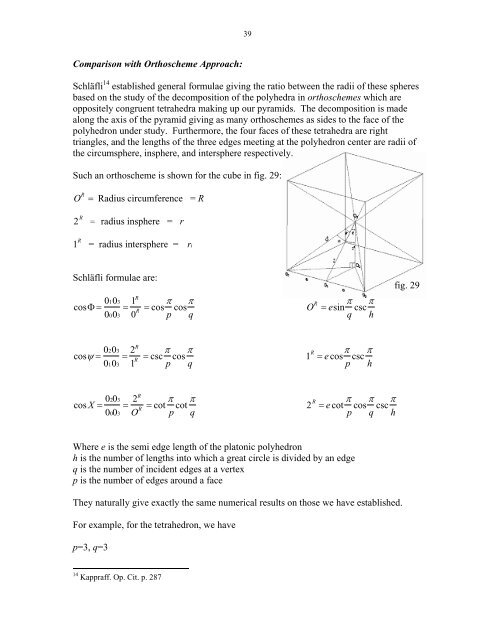Ad Quadratum Construction and Study of the Regular Polyhedra
Ad Quadratum Construction and Study of the Regular Polyhedra
Ad Quadratum Construction and Study of the Regular Polyhedra
You also want an ePaper? Increase the reach of your titles
YUMPU automatically turns print PDFs into web optimized ePapers that Google loves.
Comparison with Orthoscheme Approach:<br />
39<br />
Schläfli 14 established general formulae giving <strong>the</strong> ratio between <strong>the</strong> radii <strong>of</strong> <strong>the</strong>se spheres<br />
based on <strong>the</strong> study <strong>of</strong> <strong>the</strong> decomposition <strong>of</strong> <strong>the</strong> polyhedra in orthoschemes which are<br />
oppositely congruent tetrahedra making up our pyramids. The decomposition is made<br />
along <strong>the</strong> axis <strong>of</strong> <strong>the</strong> pyramid giving as many orthoschemes as sides to <strong>the</strong> face <strong>of</strong> <strong>the</strong><br />
polyhedron under study. Fur<strong>the</strong>rmore, <strong>the</strong> four faces <strong>of</strong> <strong>the</strong>se tetrahedra are right<br />
triangles, <strong>and</strong> <strong>the</strong> lengths <strong>of</strong> <strong>the</strong> three edges meeting at <strong>the</strong> polyhedron center are radii <strong>of</strong><br />
<strong>the</strong> circumsphere, insphere, <strong>and</strong> intersphere respectively.<br />
Such an orthoscheme is shown for <strong>the</strong> cube in fig. 29:<br />
O R Radius circumference = R<br />
2 R = radius insphere = r<br />
1 R = radius intersphere = ri<br />
Schläfli formulae are:<br />
cos 0103<br />
0003<br />
1R<br />
0 R cos <br />
p cos<br />
q OR esin <br />
csc<br />
q h<br />
cos 0203<br />
<br />
0103<br />
2R<br />
1 R csc <br />
cos<br />
p q 1Recos <br />
csc<br />
p h<br />
cos X 0203<br />
<br />
0003<br />
2R<br />
O R cot <br />
cot<br />
p q 2Recot <br />
cos csc<br />
p q h<br />
Where e is <strong>the</strong> semi edge length <strong>of</strong> <strong>the</strong> platonic polyhedron<br />
h is <strong>the</strong> number <strong>of</strong> lengths into which a great circle is divided by an edge<br />
q is <strong>the</strong> number <strong>of</strong> incident edges at a vertex<br />
p is <strong>the</strong> number <strong>of</strong> edges around a face<br />
They naturally give exactly <strong>the</strong> same numerical results on those we have established.<br />
For example, for <strong>the</strong> tetrahedron, we have<br />
p=3, q=3<br />
14 Kappraff. Op. Cit. p. 287<br />
fig. 29




